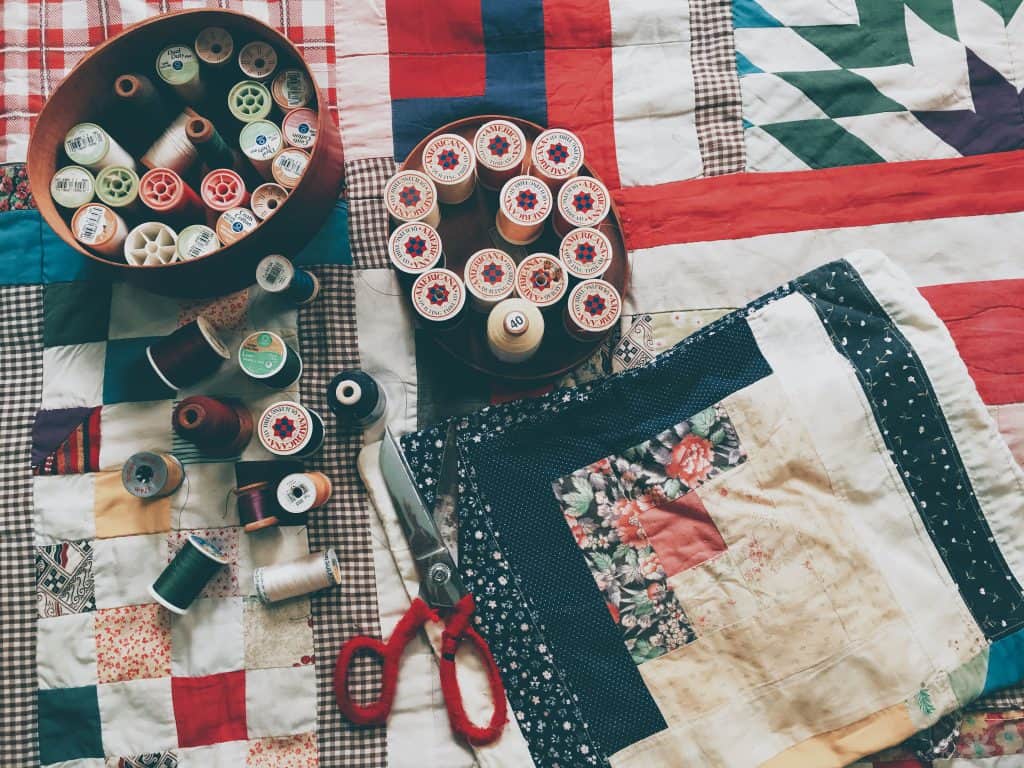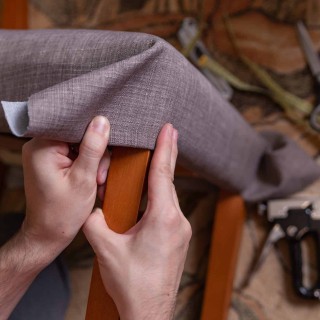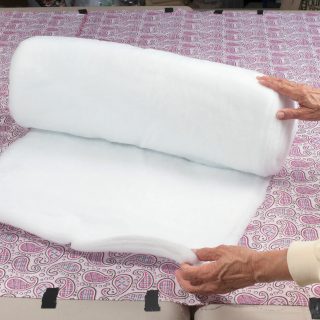Satisfying, relaxing, fun, and let’s not forget to mention useful, quilting can be a pretty time-consuming job. Especially if you’re not yet a skilled sewist, so you need to double-check the tutorial or go back a few steps to fix a mistake you only discovered later.
Before you start with your first quilting project, you should create a time frame and set some realistic expectations on when it will be finished.
There are several things to factor in when it comes to predicting the time necessary for making a quilt:
- Your skill level;
- The size of the quilt you plan on making;
- Decorations;
- Sewing technique (hand-sewn quilt or machine-sewn).
For example, if you’re making a baby quilt for a baby about to be born, or for their birthday, you should start at least 24 hours before the gifting time, as it takes at least 12 hours to finish the baby quilt. This is of course if you plan on doing everything last minute. However, you can also split your work into several days and leave room for corrections.
Now, let’s go into details on how time-consuming making a quilt can really be.
How Long Does It Take to Make a Quilt?
Many experienced sewists would agree that the minimum hours necessary for making a quilt is 15 hours. This works only if you know exactly what you’re doing if you’re machine sewing, and you’re not too ambitious with decorations.
Otherwise, it can take up to a whole year.
I will now talk a bit about all the different ways to make a quilt and explain how long it can take and why.
How Long Does It Take to Hand Sew a Quilt?
Probably the trickiest way to make a quilt is to hand sew it. However, it is difficult to estimate how long it would take.
The first thing you should think about is how much time do you actually have? How much are you ready to commit to this sewing project?
Full-time sewing day by day requires a shorter period of time compared to sewing only when you have spare time on nights and weekends.
The other important factor is how big a quilt you want to make? Baby quilts are faster finished than king-size ones, of course. Multiply this with the time you’re ready to allocate, and the answer can be anywhere between a few days and several months, especially if you plan on decorating it as well.
Finally, your expertise level also matters, as an experienced sewist usually knows what to expect and is able to predict what will happen several steps in advance, while a beginner will most likely need more time to go through the procedure.
What’s important to mention here is that hand quilting requires patience. It can be quite relaxing and fun, but also challenging, so arm yourself with perseverance and patience if it’s your first time.
Sewing a Quilt With a Sewing Machine
If you don’t want to bother with hand-sewing your quilt, using a machine is probably the best option as it’s much less energy and time-consuming.
However, even if you switch to the machine, you shouldn’t expect this to be an easy and short task.
Sewing a quilt with a sewing machine means that you know how to work with heavy, big-size fabrics.
If you are an experienced sewist, it won’t take long before you grasp the quilting with a sewing machine. Proper preparation can save you an immense amount of time. For example, you can pre-cut and pre-arrange your fabrics and patterns the way you want the final product to look.
With proper preparation, such as pre-cutting and pre-arranging your fabrics and patterns the way you want them, you can save an immense amount of time.
When you start quilting, consider pinning the quilting strips on a large canvas. Instead of canvas, you can also use a piece of fabric with patterns you wish to make.
Make sure that you have enough space for maneuvering. You will also need enough space for spreading the quilt as it goes through the machine.
Quilt size also matters when you’re machine sewing. Larger quilts take a long time to sew and organize.
One pro-tip is that you use thread in neutral colors, so you don’t need to change it with every new material color you want to sew. This can also help reduce the amount of time that it takes to complete the project.
Making a Quilt With a Quilting Machine
Maybe you haven’t seen this coming, but there are sewing machines you can purchase that are better suited for quilting than the others. In fact, I wrote a whole article about the best sewing machine for quilting, to help you with your purchasing decision
If you plan on sewing many quilts in your life, then I suggest you opt-in for a quilting machine, as it will save you a lot of time, stress, and nerves, however, if this is a one-time project, I think you’re good to go with your regular machine.
There are also benefits to purchasing a middle-option quilting machine. For example, these machines easily handle large pieces of fabric, so it’s good to have this machine for other big-size sewing projects, and you can use it for smaller projects as well, just like any other machine.
Here are some excellent quilting machines that I’ve worked on, and would highly recommend:
1. Handi Quilter Longarm Quilting Machine;
Longarm quilting machines are probably the best ones you’ll find on the market. They’re not cheap, but if you go with this one, it will most likely be the only machine you’ll ever need.
;
More friendly for the budget, but a bit more sensitive, so you’d need to be careful using it. The advantage of this machine is that it has good speed control and a hoop frame.
.
A bit more expensive piece, but the good news is that it’s the middle option between quilting only and a sewing machine.
The Quilting Machine
Quilting machines are different from regular machines as they have a huge, strong arm intended for long, multi-layered fabrics. They usually have metal frames where the arm can load all the fabric layers you are to use for sewing your quilt.
The machine head of the quilting machine can move in vertical and horizontal directions while the fabric stands still and stable. The arm is either manual or computer-controlled, depending on the exact machine model.
If the machine is automatic, you will choose the design on software and set it up by pressing the button. Then, the machine will do all the work. Manual machines require you to guide the fabric throughout the quilting process.
When using a quilting machine, fabric preparation will take up most of your time, while the quilting process goes pretty quickly if you did everything right.
This means that this is by far the fastest way to make a quilt, however, you still need to factor in the size of the quilt, as bigger quilts will take more time than smaller ones.
If you’re dealing with a very big quilt, using a quilting machine is probably the best option, especially if you’re short on time.
As preparation is the part that takes the longest when quilting with a quilting machine, you should allocate at least two hours for preparation. This involves:
- Planning your design;
- Trimming the thread;
- Patching and repairing;
- Winding the bobbin;
- Preparing the batting and backing.
Another detail to keep in mind is that for many people, quilting is kind of a sentimental process, which is why many quilters prefer to hand quilt rather than machine sew their pieces.
How Long Does It Take to Learn how to Quilt?
Well, here as well we are faced with a question with no linear answer.
The time necessary for learning how to quilt depends on several factors, just like the very process of quilting does.
First, it depends on whether you know how to sew. Knowing how to sew either with your hand or with a machine is the mandatory minimum for learning how to quilt. Quilting practically is sewing, you are just working with a particular design, and what’s peculiar to quilting, is working with huge fabric pieces.
If you know how to sew, then we can discuss the details of quilting.
The first and most important step in the quilting process is fabric preparation. Preparation is equally important in all sewing techniques: hand sewing, machine sewing, and sewing with a quilting machine.
If you make a mistake here, the whole design will go wrong.
How to Prepare Your Fabric for Quilting?
Most commonly quilts are three-layered. The layer that you will decorate is the one that requires the most work, regardless of the quilt-making technique chosen.
That’s why you should prepare all of the fabric strips you plan to use for decoration. If you plan on making patchwork, then you should pre-cut all of your pieces and sew them together.
When you finish with the first layer, you should attach it to the remaining layers. “Batting” is what we usually call the middle layer, while “backing” is the common denomination for the last (back) layer.
A quilting project will be successfully completed once these three layers are connected to each other.
These are some of the basic steps in quilting you need to master by putting them into practice and adding some patience and perseverance into your efforts.
And also, start small. If this is your first quilting project, and you immediately commit to making a king-size quilt by hand, you will probably lose your nerves in a matter of days.
Smaller quilts take less time and help you build the skills needed to switch to larger fabric pieces. Also, pick your preferred quilting technique and have consistent practice, until you achieve progress.
If you decide to purchase a quilting machine, you’re good, as all you need to know is how to prepare the fabric, and then, the machine will do all the work for you.
For those of you who already know how to sew, quilting will not be a big problem, and you will master it quickly, but if you don’t how to sew at all, I suggest you start with sewing projects for beginners and then level up your game.
Things to Know About Quilting
Quilters usually divide into two groups. Those who prefer the hand sewing technique, and those who are more skilled with the sewing machine. The thing is that quilts are often handed out as gifts to other people, and the work put into making this kind of gift is highly appreciated.
Sewing with a quilting machine of any kind is also a good option, as it will produce a fast and high-quality quilt, however, most people opt-in for the first two options, as they want to add sentimental value to their work.
Those who are only beginners in quilting should probably choose simpler patterns. The patterns are what goes onto the upper layer of your quilt. Simpler designs and easy-to-sew fabrics should be the first choice for beginners. This way it’s easy to get creative even if you’re inexperienced.
If you have no experience and no idea how to do this, I strongly recommend asking someone with more experience to teach you how. If you’re familiar with sewing, quilting should be easy to acquire for you.
Pro Tips: Saving Time on Machine Quilting
Here are a few professional time-saving tips for those who opt-in for machine quilting:
- Maintain your machine – make sure it’s always in proper order.
Keeping an orderly sewing machine is every sewist’s bread and butter, however, we should mention it. If you don’t want to waste your time on fixing a skipping needle, re-stitching, or fixing machine parts, you should clean it after each sewing project.
- Set up your working area and organize it wisely.
The least requirements are the area where you place the machine, pressing area, and working area.
- Always use a neutral thread.
I’ve already mentioned it, but I will repeat it here: always use a neutral-color thread, so you don’t need to change the thread as you change the fabric pieces. Maybe you don’t know why this is important right now, but you’ll thank me later.
What Is the Life Expectancy of a Quilt?
While making a quilt can seem overly time-consuming, just remember that a properly maintained quilt can last more than 20 years! So, however long your endeavors were, it will be worth it in the long run.
How Do I Properly Maintain My Quilt?
- Never should you ever dry clean your quilt. The chemicals they use at dry cleaning are too harsh for the delicate fabrics we most often choose for making our quilts.
- This may sound counterintuitive, but do not clean your quilt excessively. If you feel like you need to do it more often, you can just give it a bit of quick vacuuming, however, do not put your quilt in the washing machine and on high temperatures more than once a month.
- If you are to store your quilt and not use it for a while, make sure that it’s stored in an acid-free paper or cotton sheet.
- If the quilt is resting in your closet/storage place for a longer time, you should refold it from time to time so it doesn’t get permanent creases.
Conclusion
Well, that’s all from me. I hope you found this article comprehensive and informative, as quilting can be an exhausting, but also a very rewarding and emotional project for any sewist.
Looking for more tutorials?
Pay a visit to the rest of my website and check out some of the many tutorials I’ve shared!
Last update on 2025-07-03 / Affiliate links / Images from Amazon Product Advertising API







